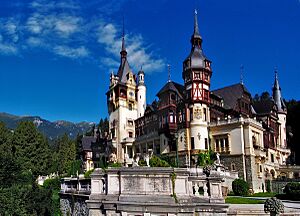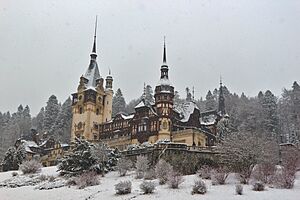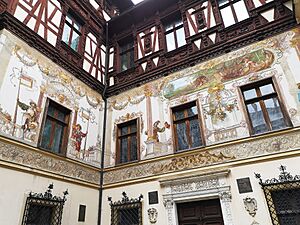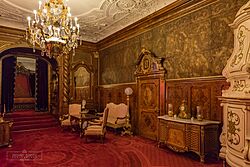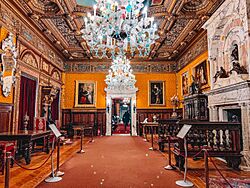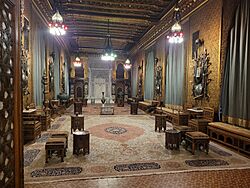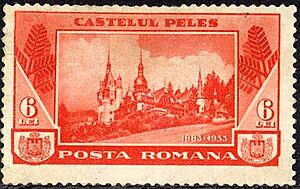Peleș Castle facts for kids
Quick facts for kids Peleș CastleCastelul Peleș |
|
|---|---|
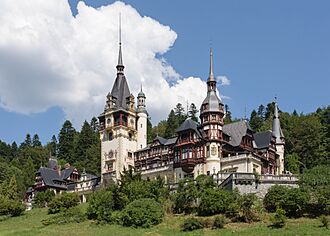
Peleș Castle in summer
|
|
| General information | |
| Architectural style | Neo-Renaissance |
| Town or city | Sinaia |
| Country | Romania |
| Coordinates | 45°21′35″N 25°32′34″E / 45.35984°N 25.54265°E |
| Construction started | 1873 |
| Completed | 1914 |
| Cost | 16,000,000 gold Romanian (approximate) lei (approx. $US 120 million today) – Cost is until the castle's opening in 1883. Further major improvements were made until 1914. |
| Client | King Carol I of Romania |
| Owner | Romanian royal family |
| Design and construction | |
| Architect | Johannes Schultz Carol Benesch Karel Liman |
Peleș Castle (which is Castelul Peleș in Romanian) is a beautiful palace in Romania. It was built in a style called Neo-Renaissance, which means "new rebirth." This style looks like old European castles. It sits high in the Carpathian Mountains, near the town of Sinaia. King Carol I of Romania had it built between 1873 and 1914. The castle officially opened in 1883.
Contents
Where is Peleș Castle?
Peleș Castle is located in the mountains of Romania. It is found northwest of the town of Sinaia. Sinaia is about 48 kilometers (30 miles) from Brașov and 124 kilometers (77 miles) from Bucharest. The castle is part of a larger area that includes two other buildings. These are Pelișor Castle and the Foișor Hunting Lodge.
The Story of Peleș Castle
How the King Chose the Spot
King Carol I of Romania first saw this area in 1866. He loved the amazing mountain views. In 1872, the King bought a large piece of land. It was near the Piatra Arsă River. This land was named the Royal Estate of Sinaia. The King wanted a royal hunting place and a summer home there. The foundation for Peleș Castle was laid on August 22, 1873.
Building the Castle and Its Features
Many other buildings were built at the same time as the castle. These included homes for guards, a building for staff, the Foișor hunting lodge, and royal stables. A power plant was also built. This plant made Peleș the first castle in the world to be fully powered by its own electricity.
The first designs for Peleș Castle were rejected by King Carol I. He thought they looked too much like other palaces and were too expensive. A German architect named Johannes Schultz then won the job. He created a unique plan for a grand mountain castle. It mixed different European styles, especially Italian and German Renaissance looks. Architect Carol Benesch also helped with the work.
Later, between 1893 and 1914, Czech architect Karel Liman added more parts. He designed the towers, including the main central tower, which is 66 meters (217 feet) tall. The Sipot Building, where Liman worked, was built later. Liman also oversaw the building of Pelișor Castle. This castle was for King Ferdinand I and Queen Marie of Romania. King Carol I and Queen Elizabeth lived in Foișor Villa while Peleș was being built.
The Cost and Workers
Building the castle between 1875 and 1914 cost a lot of money. It was about 16 million Romanian lei in gold. This would be around $120 million today. Between 300 and 400 people worked on the castle. They came from many different countries.
Queen Elisabeth of Wied wrote about the workers:
Italians were masons, Romanians were building terraces, the Gypsies were coolies. Albanians and Greeks worked in stone, Germans and Hungarians were carpenters. Turks were burning brick. Engineers were Polish and the stone carvers were Czech. The Frenchmen were drawing, the Englishmen were measuring, and so was then when you could see hundreds of national costumes and fourteen languages in which they spoke, sang, cursed and quarreled in all dialects and tones, a joyful mix of men, horses, cart oxen and domestic buffaloes.
Important Moments at the Castle
Construction slowed down during the Romanian War of Independence (1877–1878). But after the war, the plans grew, and building went quickly. In 1883, the first Orient Express train trip to Bucharest happened. Passengers were invited to Peleș Castle by Queen Elisabeth. King Carol I placed the last brick to celebrate the castle's completion. This helped make Peleș Castle and Romania's mountains famous. The castle had its official opening party on October 7, 1883.
King Carol II of Romania was born at the castle in 1893. This led King Carol I to call Peleș Castle "the cradle of the dynasty, the cradle of the nation."
Peleș Castle After the Monarchy
After King Michael I of Romania was forced to leave in 1947, the Communist government took over all royal property. This included Peleș Castle. For a short time, the castle was a tourist attraction. It was also a place for Romanian artists and writers to relax. In 1953, it became a museum.
Nicolae Ceaușescu, the Communist leader, closed the entire estate from 1975 to 1990. Only maintenance and military staff were allowed there. Ceaușescu did not like the castle much and rarely visited. In the 1980s, some of the wood in the castle got mold.
After the Romanian Revolution of 1989, Peleș and Pelișor Castles reopened to the public. Today, Foișor Castle is used as a presidential residence. The Economat Building and the Guard's Chambers Building are now hotels and restaurants. Other buildings on the estate are now tourist villas or state buildings.
In 2006, the Romanian government announced that the Royal Domain would be returned to King Michael I. After talks, the castle was leased from the royal family to the Romanian state in 2007. Peleș Castle welcomes many visitors each year, usually between 250,000 and 500,000 people.
Famous Visitors to Peleș Castle
Many important people have visited Peleș Castle. These include kings, queens, politicians, and artists. One famous visitor was Kaiser Franz Joseph I of Austria in 1896. He later wrote about how impressive the castle was. He also mentioned the beautiful gardens and the rich collections inside.
Artists like George Enescu, Sarah Bernhardt, and Vasile Alecsandri often visited. They were guests of Queen Elizabeth of Romania, who was also a writer. More recently, leaders like Richard Nixon, Gerald Ford, and Yasser Arafat were welcomed at the castle.
Peleș Castle in Movies
Peleș Castle has been featured in several movies.
- In the 2009 film The Brothers Bloom, the castle's outside was used to show a large estate in New Jersey.
- It was also seen in the Netflix movie A Christmas Prince and its two sequels.
- The castle appeared in the Hallmark Channel movies A Princess for Christmas (2011) and Royal Matchmaker (2018).
What Peleș Castle Looks Like
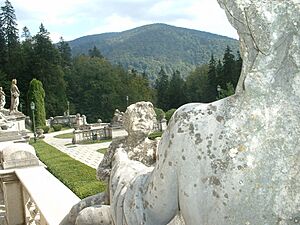
Peleș is called a castle, but it is actually a palace. Its style mixes Neo-Renaissance and Gothic Revival designs. It looks a bit like Neuschwanstein Castle in Germany. You can see a German influence in the inner courtyard. It has hand-painted murals and fancy wooden patterns. The inside of the castle is mostly Baroque style. It has heavily carved wood and beautiful fabrics.
Peleș Castle has a huge floor plan of 3,200 square meters (34,000 sq ft). It has over 170 rooms. Many rooms have special themes from different cultures around the world. Some rooms are designed for specific uses, like offices, libraries, or armories. Others are decorated in styles like Florentine, Turkish, or Moorish. All the rooms are richly furnished and decorated. There are 30 bathrooms.
The castle has many collections. These include statues, paintings, furniture, weapons, gold, silver, and stained glass. There are also collections of ivory, porcelain, tapestries, and rugs. The collection of weapons and armor has over 4,000 pieces. These pieces are from both Eastern and Western cultures. They include war items and hunting tools from four centuries.
The Oriental rugs come from places like Bukhara and Smyrna. The porcelain is from Sèvres and Meissen. The leather is from Córdoba. The hand-painted stained glass windows are mostly Swiss.
A tall statue of King Carol I stands at the main entrance. Many other statues are found in the seven Italian Neo-Renaissance gardens. These statues are mostly made of Carrara marble. The gardens also have fountains, urns, stairs, and marble paths.
Peleș Castle has almost 2,000 paintings. An Italian writer named Angelo de Gubernatis visited in 1898. He described the castle as a national monument. He noted its simple but grand style. He was impressed by the castle's courtyard and its beautiful decorations. Inside, he found amazing sculpted wood and stained glass windows.
He wrote about the Hall of Honor, which features statues of old Romanian rulers. These include Stephen the Great and Michael the Brave. He also mentioned the Queen's library, which has images of Ulfilas and Dante Alighieri.
Visiting the Museum
You can visit Peleș Castle on guided tours. There are different tours available. One tour covers the ground floor. Another adds the first floor. The full tour includes the second floor. There is an admission fee. The castle is usually open from 9 AM to 5 PM, Wednesday through Sunday. It is closed on Mondays and Tuesdays. Tickets are needed for a specific time. The castle is closed in November each year for cleaning and maintenance.
Here are some of the most famous rooms:
The Hall of Honor was finished in 1911. It covers three floors. The walls are covered in beautifully carved wood. It also has sculptures and stained glass panels. This hall features the Ancestors Gallery. This is a collection of paintings of the ancestors of the House of Hohenzollern.
The Imperial Suite is thought to be a tribute to Austrian Emperor Franz Joseph I of Austria. He visited the palace as a friend of the Romanian royal family. This room is decorated in a rich Austrian Baroque style. It has a very rare, perfectly preserved 500-year-old leather wall covering.
The Grand Armory is where 1,600 of the castle's 4,000 weapons and armor pieces are kept. It has one of Europe's best collections of hunting and war tools. These pieces are from the 14th to the 19th century. The king added pieces used in his victory against the Ottoman Turks. You can see complete Maximilian armour for a horse and rider. There is also a 15th-century German "nobles only" executioner's sword.
The Small Armory mainly displays weapons and armor from the Middle East. Many of these are made of gold and silver. They are also decorated with precious stones. You can see chainmail armor, helmets, and different types of swords and daggers.
The Playhouse is decorated in the Louis XIV style. It has sixty seats and a special Royal Box. The decorations and paintings were done by Gustav Klimt and Franz Matsch.
The Florentine Room mixes elements of the Italian Renaissance, especially from Florence. The solid bronze doors are very impressive. They were made in Rome. The large marble fireplace has designs inspired by Michelangelo.
The Moorish Salon was designed to look like North African and Spanish Moorish styles. It has furniture with mother-of-pearl designs. There are also fine Persian and Ottoman rugs. This room has an indoor marble fountain.
The Turkish Parlor creates a fun Ottoman atmosphere. It is full of Turkish rugs and copperware. This room was used as a smoking room for gentlemen. The walls are covered in handmade silk fabrics.
Unlike many royal families, the monarchs at Peleș Castle shared a bedroom.
Peleș Castle Today
Peleș Castle was originally owned by the Romanian royal family. It was taken by the state when King Michael I of Romania was forced to leave in 1947. In 1997, the castle was returned to the royal family after a long legal case that ended in 2007. King Michael I said that the castle should continue to be the Peleș National Museum. He also said it could be used for royal ceremonies sometimes.
King Michael I's heir, Princess Margareta of Romania, sometimes uses the castle. She hosts receptions and other public events there. On May 10, 2016, the royal family held a big party and concert at Peleș Castle. This was to celebrate 150 years of the Romanian Royal Dynasty. Princess Margareta's royal flag was flown from the castle. This was the first time a royal flag had flown there since 1947.
In August 2016, the body of Queen Anne of Romania lay in state in the Hall of Honor at Peleș Castle. Many important people attended, including the Romanian and Moldovan presidents. On December 13, 2017, King Michael I also lay in state in the same place. This was before his state funeral in Bucharest.
Images for kids
-
Maximilian armour in the arsenal
See also
- List of castles in Romania
- Seven Wonders of Romania
- Tourism in Romania
- Villages with fortified churches in Transylvania


